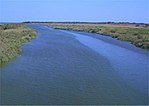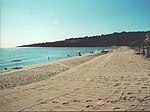Gornalunga
Italy river stubsRivers of ItalyRivers of SicilyRivers of the Province of CataniaRivers of the Province of Enna ... and 3 more
Rivers of the Province of SyracuseSicily geography stubsTributaries of the Simeto

The Gornalunga is an 81-kilometre-long (50 mi) river located in central-eastern Sicily. The river springs from Monte Rossomanno, on the Erean Mountains, in the province of Enna. After flowing through the plain of Catania, the river becomes an affluent of the Simeto river just few miles before reaching the Mediterranean coast. Along its course, the Gornalunga forms the artificial lake, Lago di Ogliastro, and touches three provinces, Enna, Catania and Syracuse.
Excerpt from the Wikipedia article Gornalunga (License: CC BY-SA 3.0, Authors, Images).Gornalunga
Sentiero Simeto Alto, Catania San Giorgio-Librino-San Giuseppe la Rena-Zia Lisa-Villaggio Sant'Agata
Geographical coordinates (GPS) Address Nearby Places Show on map
Geographical coordinates (GPS)
| Latitude | Longitude |
|---|---|
| N 37.401 ° | E 15.0608 ° |
Address
Sentiero Simeto Alto
Sentiero Simeto Alto
95121 Catania, San Giorgio-Librino-San Giuseppe la Rena-Zia Lisa-Villaggio Sant'Agata
Sicily, Italy
Open on Google Maps








